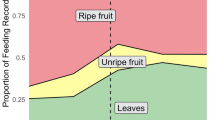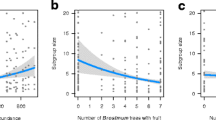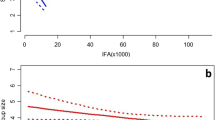Abstract
The social organization of spider monkeys (Ateles geoffroyi) and chimpanzees (Pan troglodytes) appear remarkably similar. In this paper, field studies of these two species were used to (1) test a model of ecological constraints on animal group size which suggests that group size is a function of travel costs and (2) assess ecological and social factors underlying the social organization of these two species. Spider monkeys were studied over a 6-year period in Santa Rosa National Park, Costa Rica, and chimpanzees were studied for 6 years in Kibale National Park, Uganda. Adults of both species spent their time in small subgroups that frequently changed size and composition. Thus, unlike most primate species, spider monkeys and chimpanzees were not always in a spatially cohesive social group; each individual had the option of associating in subgroups of a different size or composition. Both species relied on ripe fruit from trees that could be depleted through their feeding activity. However, spider monkey food resources tended to occur at higher densities, were more common, less temporally variable, and did not reach the low levels experienced by chimpanzees. Analyses of the relationship between subgroup size and the density and distribution of their food resources suggested that travel costs limit subgroup size. However, these ecological factors did not influence all age/sex classes equally. For example, the number of adult males in a subgroup was a function of food density and travel costs. However, this was not the case for female chimpanzees, suggesting that the benefits of being in a subgroup for females did not exceed the costs, even when ecological conditions appeared to minimize subgroup foraging costs. Therefore, it seems likely that social strategies influenced the relationship between food resource variables and subgroup size.
Similar content being viewed by others
References
Altmann S (1974) Baboons, space, time, and energy. Am Zool 14: 221–248
Bradbury JW, Vehrencamp SL (1977) Social organization and foraging in emballonurid bats. 11. A model for the determination of group size. Behav Ecol Sociobiol 1: 383–404
Butynski TM (1990) Comparative ecology of blue monkeys (Cercopithecus mitis) in high- and low-density subpopulations. Ecol Monogr 60: 1–26
Chapman CA (1987) Flexibility in diets of three species of Costa Rican primates. Folia Primatol 49: 90–105
Chapman CA (1988) Patch use and patch depletion by the spider and howling monkeys of Santa Rosa National Park, Costa Rica. Behaviour 105: 99–116
Chapman CA (1990a) Association patterns of spider monkeys: The influence of ecology and sex on social organization. Behav Ecol Sociobiol 26: 409–414
Chapman CA (1990b) Ecological constraints on group size in three species of neotropical primates. Folia Primatol 55: 1–9
Chapman CA, Chapman LJ (1990) Density and growth rate of some tropical dry forest trees: Comparisons between successional forest types. Bull Torrey Bot Club 117: 226–231
Chapman CA, Lefebvre L (1990) Manipulating foraging group size: Spider monkey food calls at fruiting trees. Anim Behav 39: 891–896
Chapman CA, Wrangham RW (1993) Range use of the forest chimpanzees of Kibale: Implications for the evolution of chimpanzee social organization. Am J Primatol 31: 263–273
Chapman CA, Chapman LJ, McLaughlin RL (1989) Multiple central place foraging by spider monkeys: travel consequences of using many sleeping sites. Oecologia 79: 506–511
Chapman CA, Chapman LJ, Wrangham RW, Hunt K, Gebo D, Gardner L (1992) Estimators of fruit abundance of tropical trees. Biotropica 24: 527–531
Chapman CA, White FJ, Wrangham RW (1993) Defining subgroup size in fission-fusion societies. Folia Primatol 61: 31–34
Charnov EL (1976) Optimal foraging: the marginal value theorem. Theor Popul Biol 9: 129–136
Clark A, Wrangham R (1993) Acoustic analysis of wild chimpanzee pant hoots: do Kibale forest chimpanzees have an acoustically distinct food arrival pant hoot? Am J Primatol 31: 99–109
Clutton-Brock TH, Harvey PH (1977). Primate ecology and social organization. J Zool 183: 1–39
Dittus W (1979) The evolution of behaviour regulating density and age-specific sex ratios in a primate population. Behaviour 69: 265–302
Eisenberg JF (1973) Reproduction in two species of spider monkeys Ateles fusciceps and Ateles geoffroyi. J Mammal 54: 955–957
Fedigan LM, Baxter MJ (1984) Sex differences and social organization in free-ranging spider monkeys (Ateles geoffroyi). Primates 25: 279–294
Ghiglieri MP (1984) The chimpanzee of Kibale Forest. Columbia University Press, New York
Goodall J (1986) The chimpanzees of Gombe. Harvard University Press, Cambridge
Hauser MD (1990) Do chimpanzee copulatory calls incite malemale competition? Anim Behav 39: 596–597
Janson CH, Schaik CP van (1988) Recognizing the many faces of primate food competition: Methods. Behaviour 105: 165–186
Klein LL (1971) Observations on copulation and seasonal reproduction of two species of spider monkeys, Ateles belzebuth and A. geoffroyi. Folia Primatol 15: 233–248
Klein LL (1972) The ecology and social organization of spider monkeys Ateles belzebuth. Ph.D. Dissertation, University of California, Berkeley
Klein LL (1974) Agonistic behaviour in neotropical primates. In: Holloway L (ed) Primate aggression, territoriality, and xenophobia. Academic Press, New York, pp 77–122
Klein LL, Klein DB (1977) Feeding behaviour of the Columbian spider monkey, Ateles belzebuth. In: Clutton-Brock TH (ed) Primate ecology. Academic Press, London, pp 153–181
Leighton M, Leighton DR (1982) The relationship of size and feeding aggregate to size of food patch: Howler monkeys (Alouatta palliata) feeding in Trichilia cipo fruit trees on Barro Colorado Island. Biotropica 14: 81–90
MacDonald DW (1979) The flexible social system of the golden jackal, Canis aureus. Behav Ecol Sociobiol 5: 17–38
Milton K (1981) Food choice and digestive strategies of two sympatric primate species. Am Nat 117: 496–505
Milton K (1984) Habitat, diet, and activity patterns of free-ranging wooly spider monkeys (Brachyteles arachnoides E. Geoffroyi 1806). Int J Primatol 5: 491–514
Peters R, Cloutier S, Dube D, Evans A, Hastings P, Kohn D, Sawer-Foner B (1988) The ecology of the weight of fruit on trees and shrubs in Barbados. Oecologia 74: 612–616
Robbins D, Chapman CA, Wrangham RW (1991) Group size and stability: Why do gibbons and spider monkeys differ? Primates 32: 301–305
Rondinelli R, Klein LL (1976) An analysis of adult social spacing tendencies and related social interactions in a colony of spider monkeys (Ateles geoffroyi) at the San Francisco Zoo. Folia Primatol 25: 122–142
Skorupa J (1988) The effect of selective timber harvesting on rainforest primates in Kibale Forest, Uganda. Ph.D. Dissertation, University of California, Davis
Sokal R, Rohlf F (1981) Biometry. Freeman, San Francisco
Stephens DW, Krebs JR (1986) Foraging theory. Princeton University Press, Princeton
Strier KB (1989) Effects of patch size on feeding associations in muriquis (Brachyteles arachnoides). Folia Primatol 52: 70–77
Struhsaker TT (1980) Comparison of the behaviour and ecology of red colobus and redtail monkeys in the Kibale Forest, Uganda. Afr J Ecol 18: 33–51
Struhsaker TT, Leland L (1979) Socioecology of five sympatric monkey species in the Kibale Forest, Uganda. Adv Study Behav 9: 159–227
Symington M (1988) Demography, ranging patterns, and activity budgets of black spider monkeys (Ateles paniscus chamek) in the Manu National Park, Peru. Am J Primatol 15: 45–67
Symington M (1990) Fission-fusion social organization in Ateles and Pan. Int J Primatol 11: 47–61
Terborgh J (1983) Five new world primates. Princeton University Press, Princeton
Terborgh J, Janson CH (1986) The socioecology of primate groups. Annu Rev Ecol Syst 17: 111–135
Tutin CEG (1979) Mating patterns and reproductive strategies in a community of wild chimpanzees (Pan troglodytes schweinfurthii). Behav Ecol Sociobiol 6: 29–38
White FJ, Wrangham RW (1988) Feeding competition and patch size in the chimpanzee species Pan paniscus and Pan troglodytes. Behaviour 105: 148–164
Whitten PL (1983) Diet and dominance among female vervet monkeys (Cercopithecus aethiops). Am J Primatol 5: 139–159
Wrangham RW (1977) Feeding behaviour of chimpanzees in Gombe National Park, Tanzania. In: Clutton-Brock TH (ed) Primate ecology. Academic Press, London, pp 504–538
Wrangham RW, Smuts BB (1980) Sex differences in the behavioural ecology of chimpanzees in the Gombe National Park, Tanzania. J Reprod Fert 28: 13–31
Wrangham RW, Conklin NL, Chapman CA, Hunt KD (1991) The significance of fibrous foods for Kibale Forest chimpanzees. Phil Trans R Soc London 334: 171–178
Wrangham RW, Clark AP, Isabirye-Basuta G (1992) Female social relationships and social organization of Kibale Forest Chimpanzees. In: Nishida T, McGrew WC, Marler P, Pickford M, Waal F de (eds) Human origins. Tokyo University Press, Tokyo, pp 81–98
Wrangham RW Gittleman JL, Chapman CA (1993) Constraints on group size in primates and carnivores: population density and day-range as assays of exploitation competition. Behav Ecol Sociobiol 32: 199–210
Wrangham RW, Chapman CA, Chapman LJ (1994) Seed dispersal by forest chimpanzees. J Trop Ecol 10: 355–368
Author information
Authors and Affiliations
Additional information
Communicated by M.A. Elgar
Rights and permissions
About this article
Cite this article
Chapman, C., Chapman, L. & Wrangham, R. Ecological constraints on group size: an analysis of spider monkey and chimpanzee subgroups. Behav Ecol Sociobiol 36, 59–70 (1995). https://doi.org/10.1007/BF00175729
Received:
Accepted:
Issue Date:
DOI: https://doi.org/10.1007/BF00175729




